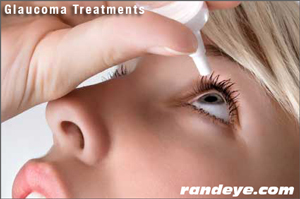January is Glaucoma Awareness Month
Happy New Year! May 2021 bring us all health, peace and happiness.
Glaucoma is called “The Thief of Sight” because it occurs so gradually that you may not even be aware that you are experiencing vision loss due to glaucoma. Glaucoma occurs when pressure in the eye becomes higher than normal resulting in increased pressure on the optic nerve, pinching the blood vessels that carry blood to the retina and optic nerve.
While many people schedule a baseline screening every year or so, the BEST way to prevent glaucoma is with a comprehensive eye exam. Some people have a higher risk of developing glaucoma. If you are in any of these categories, please call us for a full eye exam:
- Relatives with glaucoma
- African, Asian, or Hispanic background
- Farsighted or nearsighted vision
- High eye pressure on previous exam
- Have diabetes, migraines, or high blood pressure
- Long term use of steroids
Glaucoma is one of the leading causes of blindness but it does not have to happen to you. Early testing and prevention are extremely important, especially since there is no known cure. For vision already lost due to glaucoma these are three procedures that can help to stop glaucoma in its tracks. If you are diagnosed with glaucoma, we can explain these options thoroughly and choose which is best suited for your condition. The goal of any treatment is to lower your eye pressure to a safe level.
- Prescription eye drops
- Laser glaucoma surgery
- Filtration surgery
Anyone can be at risk from glaucoma; everyone from babies to senior citizens can be at risk. Actually, 1 out of every 10,000 babies is born with glaucoma.
Here is the key: When glaucoma is diagnosed and treated adequately, vision can be preserved rarely ending in blindness, hence, the upmost importance of regular eye exams.
What can I do to prevent Glaucoma?
For Glaucoma Awareness Month, here are answers to the often-asked questions about early detection and prevention of this eye disease that affects more than 3-million people in the U.S., nearly half of whom are unaware that they have glaucoma. It’s time to become more aware.
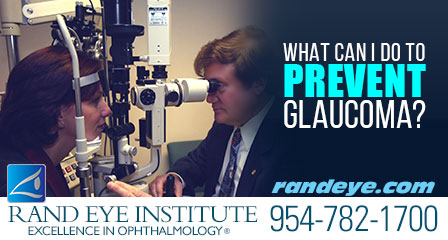
What can I do to prevent Glaucoma?
Preventing glaucoma is only possible if you know that it’s oncoming. Since knowledge is power, early detection is critical. A comprehensive, dilated eye exam is the first crucial step to warding off this vision-stealing condition before it arrives and to halt its progression before irreversible damage occurs. Patients should have these exams beginning at age 40 and then every two years from age 65, with more frequent screenings if you’re in a high-risk category.
How Can I Determine my At Risk Factor?
Your family’s eye health history plays a huge role in determining whether you’re in a high-risk category. Being of African, Asian or Hispanic heritage can put you at higher risk, being over 40, having high eye pressure detected in an exam, being farsighted or nearsighted, or if you’ve experienced eye trauma or an eye injury. Those who have other health problems such as diabetes, migraines, high blood pressure or poor blood circulation should have regular eye exams to stay ahead of glaucoma.
Taking the Right “Steps”
Regular exercise may help prevent glaucoma, as it is known to help relieve pressure in the eye, so keep moving and help keep it away.
It’s Really a Cover-up
Wearing eye protection when working with power tools, splintering wood, welding or hammering can help prevent serious eye injuries that can lead to glaucoma. Wearing eye and head protection during sporting activity is also highly recommended, especially when participating in high-speed racquet sports.
Vision loss from glaucoma currently cannot be reversed; therefore the key is prevention and/or control. Please see your ophthalmologist or regular eye care doctor to schedule your comprehensive eye exam and leave glaucoma in the rear view mirror.
Glaucoma: Let’s Take the Pressure Off to Help You See Better
This month, the buzz is all about Glaucoma during National Glaucoma Awareness Month.
In last month’s blog, we explained glaucoma. Today we want to present some of the effective treatments for glaucoma, which is now one of the leading causes of blindness.
Because glaucoma is caused by increased pressure in the eye, the first plan of treatment is to lower the pressure within normal values.
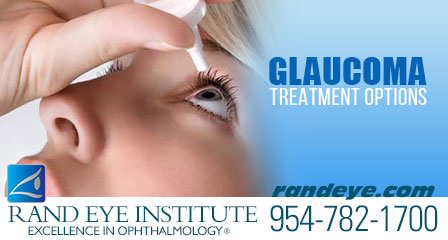
Here are three main ways to accomplish this:
Eye Drops: The most common and convenient treatment for lowering intraocular pressure (IOP) inside the eye. Prescription eye drops can lower your IOP, offering a chance for the excess fluid to escape the eye via the trabecular meshwork/Schlemm’s canal (TM/SC) and the uveoscleral pathway. Ask your doctor to explain the options best suited for your condition.
Laser Surgery: This option is often suggested before the doctor will recommend incisional surgery. With laser surgery, a focused beam of light is used to help control the eye pressure, by enhancing the eye drainage function. In some cases, the laser treatment, known as iridotomy, is used to make tiny holes in the iris to help improve drainage, effectively lowering pressure in the eye.
Operative Surgery: When eye drops and laser surgery are not as effective, the doctor may suggest operative surgery to create a new bypass drainage tunnel. The fluid can properly drain through this new path allowing for pressure in the eye to reduce, offering relief and improved vision.
Rand Eye-Q tip: Reducing your intake of alcohol and caffeine are highly recommended options that can help stave-off glaucoma, and of course, smoking cessation is always great advice.
Consult with your ophthalmologist for the options best suited for you. Click here to schedule a comprehensive eye exam at Rand Eye Institute.
January is Glaucoma Awareness Month
See The New Year Crystal Clear!
Happy New Year! We hope you SEE happy times ahead in 2017 and we have some vision advice to help make that happen.
January is Glaucoma Awareness Month. Glaucoma is called “The Sneak Thief of Sight” because it occurs so gradually that you may not even be aware that you’re developing vision loss due to glaucoma.
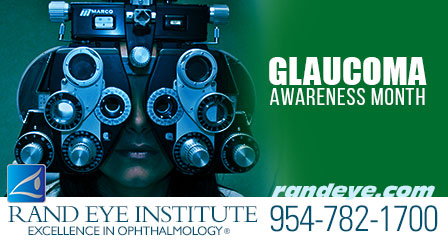
Glaucoma occurs when pressure in the eye becomes higher than normal resulting in increased pressure on the optic nerve, pinching the blood vessels that carry blood to the retina and optic nerve.
While many people schedule a baseline screening every year or so, the BEST way to prevent glaucoma is with a comprehensive dilated eye exam. In a comprehensive eye exam, your eye pressure will be tested as well as the front part of your eye, retina and optic nerve.
Glaucoma is one of the leading causes of blindness but it doesn’t have to happen to you. Early testing and prevention are extremely important, especially since there is no known cure. There are three procedures that can help to stop or regulate glaucoma in its tracks. If diagnosed, your doctor can explain these options thoroughly and choose which is best suited for your condition:
- Prescription eye drops
- Laser surgery
- Filtration surgery
You don’t have to be elderly to be at risk from glaucoma, everyone from babies to senior citizens can be at risk, in fact, 1 out of every 10,000 babies born in the U.S. are born with glaucoma.
Here’s the key: When glaucoma is diagnosed early and treated adequately, it rarely ends in blindness. That’s why it’s so important to have regular eye exams. Click here to schedule an appointment at Rand Eye Institute.
Glaucoma Symptoms
Glaucoma refers to a group of eye disorders that can all cause damage to the optic nerve that carries information from the eye to the brain.
Glaucoma usually has few or no initial symptoms. This is why eye checkups should be scheduled regularly.
In the majority of cases, glaucoma is associated with having higher-than-normal pressure inside the eye. But it can also occur when intraocular pressure (IOP) is normal.
If it goes untreated or uncontrolled, glaucoma can cause peripheral vision loss and can even lead to blindness.
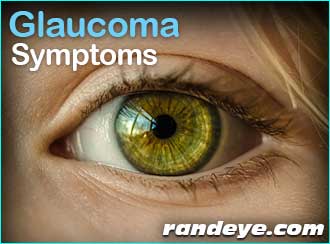
Types of Glaucoma and Symptoms
Primary open-angle glaucoma.
- This common type of glaucoma gradually reduces your peripheral vision without other symptoms. By the time you notice it, permanent damage already has occurred.
- If your IOP remains high, the loss of your vision can progress until tunnel vision, and you will be able to see only objects that are straight ahead.
- Ultimately, all vision can be lost, leading to blindness.
Acute angle-closure glaucoma.
- This is also called narrow-angle glaucoma.
- This type of glaucoma produces sudden symptoms such as eye pain, headaches, halos around lights, dilated pupils, vision loss, red eyes nausea and vomiting.
Normal-tension glaucoma.
- Normal-tension glaucoma is a type of open-angle glaucoma that can cause visual field loss due to optic nerve damage.
- In normal-tension glaucoma, the eye’s IOP remains in the normal range.
- Pain is unlikely and permanent damage to the eye’s optic nerve will most likely not be noticed until symptoms such as tunnel vision occur.
- The cause of normal-tension glaucoma is still not known. Many doctors believe it is related to poor blood flow to the optic nerve.
- Normal-tension glaucoma is more common in those who are Japanese, are female and/or have a history of vascular disease.
Congenital glaucoma.
- This is an inherited form of glaucoma, and is present at birth, with 80 percent of cases diagnosed by age one.
- Children diagnosed with this type of Glaucoma are born with narrow angles or another type of defect in the drainage system of the eye.
- It’s hard to spot the signs of congenital glaucoma, because children most likely do not understand what is happening to them or notice the changes in vision.
- If you notice a cloudy, white, hazy, enlarged or protruding eye in your child, talk to your eye doctor.
Glaucoma Treatment Options
In general glaucoma cannot be completely cured, but it can be controlled.
Most treatments for glaucoma are designed to reduce or control the intraocular pressure (IOP), which can damage the optic nerve that transmits visual information to the brain.

Treatment for glaucoma depends on the severity of each case.
Glaucoma Treatments:
Medicine
Glaucoma is often treated with eye drops that are taken several times each day.
The eye drops help the way the eye fluid circulates as well as lowers eye pressure, by decreasing the production of fluid within the eye or by increasing the flow leaving the drainage angle.
Glaucoma can worsen over time without you even being aware, so your treatment will likely change in order to help achieve a lower eye pressure.
Laser Surgery
Laser surgery is also effective for glaucoma treatment. There are two main types:
- Trabeculoplasty is a type of laser treatment that enhances eye drainage function and helps control eye pressure within the eye when treating open-angle glaucoma.
- Iridotomy is a laser treatment that makes tiny holes in the iris to help improve the flow of eye fluid to the drain when treating narrow angle.
Operative Surgery
If both the eye drops and laser therapy treatment have not been successful in lowering the eye pressure, your doctor might suggest an operative surgery to be performed.
With this surgery a new bypass drainage tunnel will be created using a microscope and specialized instruments, to help the eye fluid to leave the eye.
Each case of glaucoma is different and treated differently. Talking to your doctor can help you distinguish which treatment is best for you.
With any type of glaucoma, regular eye examinations are very important.
Glaucoma Disease Risk Factors
Glaucoma is a disease that causes damage to the eye’s optic nerve.
The optic nerve, which is connected to the retina and is made up of many nerve fibers, is responsible for sending signals from your retina to your brain. These signals are interpreted as the images you see.
In a healthy eye, a clear fluid called aqueous humor circulates the front portion of your eye.

To maintain a constant healthy eye pressure, your eye continually produces a small amount of aqueous humor while an equal amount of this fluid flows out and leaves your eye.
If you have glaucoma, the aqueous humor does not flow out of the eye in the way that it should. Fluid pressure in the eye builds up and, over time, causes damage to the optic nerve fibers.
If left untreated, Glaucoma can lead to vision loss and eventually can even lead to blindness.
Here are some of the factors that may put you at risk for Glaucoma…
Age-
- People over 60 are at increased risk for the disease.
- The risk of developing glaucoma actually increases with every year of age.
- African Americans have an increase risk beginning at the age of 40.
Ethnic Background-
- African-Americans older than age 40 have much higher risk of developing glaucoma than do Caucasians.
- African-Americans also are more likely to experience permanent blindness as a result of glaucoma.
- People of Asian descent have an increased risk of developing acute angle-closure glaucoma.
- People of Japanese descent may be more likely to have normal-tension glaucoma.
Family history of glaucoma-
- If you have a family history of glaucoma, you have a greater risk of developing it.
- Glaucoma may have a genetic link, meaning there’s a defect in one or more genes that may cause certain individuals to be more susceptible to the disease.
- A form of juvenile open-angle glaucoma has been clearly linked to genetic abnormalities.
Medical conditions-
- Several conditions may increase your risk of developing glaucoma, including diabetes, heart diseases, high blood pressure and hypothyroidism.
- Previous eye injuries can also build up to Glaucoma.
It is recommended that you get regular eye exams. Early detection and treatment is the best way to minimize the risks of Glaucoma.
Glaucoma Treatments
Treatment for glaucoma depends on the nature and severity of each case. In general glaucoma cannot be completely cured, but it can be controlled. Most treatments for glaucoma are designed to reduce or control intraocular pressure (IOP), which can damage the optic nerve that transmits visual information to the brain. With any type of glaucoma, regular eye examinations are very important.
Glaucoma Modes of Treatment:
Medicine
Glaucoma is often treated with eye drops that are taken regularly several times a day. The eye drops help alter the circulation of the eye fluid and lower eye pressure, by either decreasing the production of fluid within the eye or by increasing the flow leaving the drainage angle. Because glaucoma can worsen over time without you being aware of it, your treatment will likely change in order to achieve a lower eye pressure.
Laser Surgery
Laser surgery is also effective for glaucoma treatment. Trabeculoplasty is a type of laser treatment that enhances eye drainage function to help control eye pressure within the eye when treating open-angle glaucoma. Iridotomy is a laser treatment that makes tiny holes in the iris to help improve the flow of eye fluid to the drain when treating narrow angle
Operative Surgery
If eye drops and laser therapy treatment have not been successful in lowering the eye pressure, your doctor might suggest operative surgery, where a new bypass drainage tunnel will be created using a microscope and specialized instruments, in order for the eye fluid to leave the eye.
Each case of glaucoma is different and treated differently. Talking to your doctor can help you distinguish which treatment is best for you.
Glaucoma Symptoms & Types
Glaucoma refers to a group of related eye disorders that all cause damage to the optic nerve that carries information from the eye to the brain. Glaucoma usually has few or no initial symptoms. 
In most cases, glaucoma is associated with higher-than-normal pressure inside the eye. But it also can occur when intraocular pressure (IOP) is normal. If untreated or uncontrolled, glaucoma first causes peripheral vision loss and eventually can lead to blindness.
Types and Symptoms of Glaucoma
Primary open-angle glaucoma. This common type of glaucoma gradually reduces your peripheral vision without other symptoms. By the time you notice it, permanent damage already has occurred. If your IOP remains high, the destruction can progress until tunnel vision develops, and you will be able to see only objects that are straight ahead. Ultimately, all vision can be lost, causing blindness.
Acute angle-closure glaucoma. Also called narrow-angle glaucoma, acute angle-closure glaucoma produces sudden symptoms such as eye pain, headaches, halos around lights, dilated pupils, vision loss, red eyes nausea and vomiting.
Normal-tension glaucoma. Normal-tension glaucoma is a type of open-angle glaucoma that can cause visual field loss due to optic nerve damage. But in normal-tension glaucoma, the eye’s IOP remains in the normal range. Also, pain is unlikely and permanent damage to the eye’s optic nerve may not be noticed until symptoms such as tunnel vision occur. The cause of normal-tension glaucoma is not known. Many doctors believe it is related to poor blood flow to the optic nerve. Normal-tension glaucoma is more common in those who are Japanese, are female and/or have a history of vascular disease.
Congenital glaucoma. This inherited form of glaucoma is present at birth, with 80 percent of cases diagnosed by age one. These children are born with narrow angles or some other defect in the drainage system of the eye. It’s difficult to spot signs of congenital glaucoma, because children are too young to understand what is happening to them. If you notice a cloudy, white, hazy, enlarged or protruding eye in your child, consult your eye doctor.
Glaucoma Awareness Month 2015
Glaucoma is a disease that damages the eye’s optic nerve. The optic nerve is connected to the retina and is made up of many nerve fibers; the optic nerve is responsible for sending signals from your retina to your brain, where these signals are interpreted as the images you see.
In a healthy eye, a clear fluid called aqueous humor circulates the front portion of your eye. To maintain a constant healthy eye pressure, your eye continually produces a small amount of aqueous humor while an equal amount of this fluid flows out of your eye. If you have glaucoma, the aqueous humor does not flow out of the eye properly. Fluid pressure in the eye builds up and, over time, causes damage to the optic nerve fibers.
If left untreated, Glaucoma can lead to vision loss and eventually blindness.
Glaucoma Risk Factors:
Age
People over 60 are at increased risk for the disease. African Americans have an increase risk begin at the age of 40. The risk of developing glaucoma increases with every year of age.
Ethnic background
African-Americans older than age 40 have much higher risk of developing glaucoma than do Caucasians. African-Americans also are more likely to experience permanent blindness as a result of glaucoma. People of Asian descent have an increased risk of developing acute angle-closure glaucoma. People of Japanese descent may be more likely to have normal-tension glaucoma.
Family history of glaucoma
If you have a family history of glaucoma, you have a greater risk of developing it. Glaucoma may have a genetic link, meaning there’s a defect in one or more genes that may cause certain individuals to be more susceptible to the disease. A form of juvenile open-angle glaucoma has been clearly linked to genetic abnormalities.
Medical conditions
Several conditions may increase your risk of developing glaucoma, including diabetes, heart diseases, high blood pressure and hypothyroidism. Previous eye injuries can also cause glaucoma.

